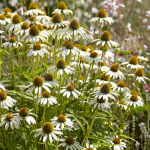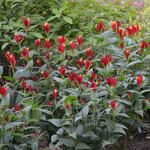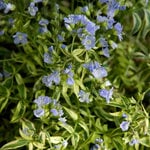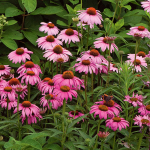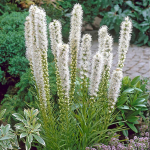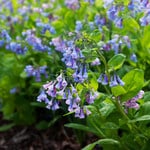Product Details
Are you new to gardening? (Even if you’re not, would you like a garden of plants that will feed and support hummingbirds especially during the spring migration season?) Our Start a Garden for Hummingbirds: Native Plants for Part Shade collection contains 6 different perennials (plants that return year after year) that all thrive in part shade (defined as 3 to 4 hours of direct sun per day) and slightly moist soil that is rich in organic matter. The plants are all North American natives, which means they occur naturally in our area of the world and have co-evolved with hummingbirds and other wildlife for hundreds of years. These hardy, vigorous native perennials were chosen by our horticultural experts to provide ease of care and a feast for hummingbirds, especially in the early part of the season. These native perennials are ideal for beginners. 1 plant of each variety listed below, 2 plants of the Phlox, 7 plants total. Covers approximately 35 sq ft. Planting diagram included.
- 1 Mertensia virginica (Virginia Bluebells)
- 2 Phlox stolonifera ‘Blue Ridge' (Creeping Phlox)
- 1 Aquilegia canadensis (Canada Columbine)
- 1 Polemonium reptans ‘Stairway to Heaven’ (Creeping Jacob’s Ladder)
- 1 Spigelia marilandica 'Little Redhead' (Indian Pink)
- 1 Heuchera villosa ‘Autumn Bride’ (Coral Bells)
Before purchase, you’ll need to know your USDA Plant Hardiness Zone. This will determine whether or not the plants in this collection are hardy in your area and able to tolerate regional extremes of heat and cold. Click here to learn more about hardiness zones and to find yours. If your zone is between 5-8, this garden is for you.
What can you expect?
The buffet of nectar-rich hummingbird favorites opens for business in early spring with the sapphire-blue blossoms of Mertensia virginica (Virginia Bluebells), which flowers in April and May here at the farm. This plant goes dormant in summer, which is why we recommend situating it behind the Phlox and Aquilegia to provide cover for the fading foliage. This plant thrives in moist soil, where it will seed itself to create a colorful colony.
Next to blossom is Phlox stolonifera (Creeping Phlox) ‘Blue Ridge,’ which will carpet a shady spot with lilac-blue flowers that attract hummingbirds and other pollinators. If your part-shade garden has an area that is shadiest, this Phlox will appreciate that spot. It will gradually form a dense mat of evergreen to semi-evergreen foliage and spread to form a weed-suppressing mat.
Aquilegia canadensis (Canada Columbine) flowers in mid-spring, producing nodding blooms in shades of red and yellow. The flowers are suspended on slender stems, giving them the appearance of little lanterns that light the way for hummingbirds. This plant grows well in both part shade and full sun so if you have a sunnier spot in your part-shade garden, plant it there.
Polemonium reptans (Creeping Jacob’s Ladder) ‘Stairway to Heaven’ is another mid-spring bloomer, its sprays of bell-shaped blue flowers providing nectar for hummingbirds even as gardeners may be equally pleased by the plant’s low mound of green-and-white variegated foliage. Creeping Jacob’s Ladder prospers in evenly moist, woodsy soil and along the banks of streams. In spots where the soil remains consistently moist, it will also thrive in full sun.
Mirroring the colors of Aquilegia canadensis are the upright tubular flowers of Spigelia marilandica 'Little Redhead,' which blossoms in late spring (June in our part of the world). Each bold red flower has a yellow interior that reveals itself in the shape of a gold star at the opening. The plant’s gleaming green foliage provides texture and shine over a long season. ‘Little Redhead’ thrives in moist, part-shade areas and will spread slowly in a site it likes. The blossoms last for weeks with some possibility of intermittent repeat bloom into autumn.
Long after the spring flowers in this Start a Garden collection have subsided, late-summer and fall-flowering Heuchera villosa ‘Autumn Bride’ helps fuel hummingbirds for their late summer migration. Before flowering, this highly distinctive Coral Bells offers a full season of fuzzy, pale green, lobed leaves. As August arrives, it crowns them with 2' spikes topped with white-to-blush pink flowers that persist until a hard frost. This weed-smothering plant is also an excellent ground cover.
Plants in your Start a Garden collection will arrive in one of two forms: potted and/or bareroot. Bareroots may sound intimidating, but they’re not. In fact, they’re remarkably easy to plant. Visit the Growing Guide (see tab above) to learn more now or consult the Quick Start Guide you will receive when your new garden arrives.
Enjoy a garden of beautiful, interesting, part-shade native perennials that will attract and support hummingbirds for years to come. We hope it’s the start of many great gardening adventures.
For more information on growing and care, click Growing Guide.
Shipping
HOW PLANTS ARE SHIPPED
The size of the plants we ship has been selected to reduce the shock of transplanting. For some, this means a large, bareroot crown. Others cannot travel bareroot or transplant best if grown in containers. We ship these perennials and annuals in 1 pint pots, except as noted. We must point out that many perennials will not bloom the first year after planting, but will the following year, amply rewarding your patience. We ship bulbs as dormant, bare bulbs, sometimes with some wood shavings or moss. Shrubs, Roses, vines, and other woody plants may be shipped bareroot or in pots. The size of the pot is noted in the quick facts for each item.
WHEN WE SHIP
We ship our bulbs and plants at the right time for planting in your area, except as noted, with orders dispatched on a first-come, first-served basis by climate zone. We also ship a wide range of containers and planters, tools, supplies, fertilizers, garden wear, garden decor items, as well as indoor decorations like wreaths and dried bouquets when available. Estimated dates for shipping are indicated in the green Shipping Details box for each item. Please supply a street address for delivery. Kindly contact us with two weeks notice, if you'll be away at the expected time of delivery.
OUR GUARANTEE
We guarantee to ship plants that are in prime condition for growing. If your order is damaged or fails to meet your expectations, we will cheerfully replace or refund it. Please contact our Customer Service Department at 1-800-503-9624 or email us at [email protected]. Please include your order number or customer number when contacting us.
Reviews
There are no reviews yet. Be first to Write a Review.
Growing guide
Welcome to the world of gardening & our Start a Garden series
Growing Your Start a Garden for Hummingbirds: Native Plants for Part Shade
The Start a Garden for Hummingbirds: Native Plants for Part Shade contains 6 different perennials (plants that return year after year) that all thrive in part shade (defined as 3 to 4 hours of direct sun per day) and slightly moist soil that is rich in organic matter. The plants are all North American natives, which means they occur naturally in our area of the world and have co-evolved with hummingbirds and other wildlife for hundreds of years. These hardy, vigorous native perennials were chosen by our horticultural experts to provide ease of care and a feast for hummingbirds, especially in the early part of the season. These native perennials are ideal for beginners.
As you begin your first garden adventure, keep in mind that freshly planted perennials need time to settle in and establish roots. In their first season, they will divert much of their energy to this task. As a result, your plants may or may not flower in their first year. Waiting for plants to settle and grow is a process by which many gardeners begin to develop one of the most important traits a green thumb can possess: patience. Giving a plant the time it requires to settle in will produce rewards in subsequent seasons. Experienced gardeners know that in a first year, a perennial “sleeps.” In the second year, it “creeps.” And by the third year, it “leaps.” Watch over time as your perennials gain in size, forming broader clumps, and increasing their flower show. As a general rule, it takes three years for a plant to reach its mature size.
This guide includes the following sections:
- Knowing & Growing Your Plants
- About Bareroot Plants
- Laying Out Your Garden
- Caring for Your Garden
- Companions
- Calendar of Care
- Mertensia virginica (Common name: Virginia Bluebells)
Despite their blue flower color, Virginia Bluebells are attractive to hummingbirds who feed on their nectar in early spring. Plants go dormant and their foliage disappears by midsummer, leaving a gap where they are planted. Mark their location to avoid damaging roots if digging late in the season. Your Mertensia will be shipped to you as an easy-to-plant bareroot. If you’re not familiar with the term, a bareroot is exactly what it sounds like: a healthy division of a mature plant that includes a portion of its roots (minus most or all green growth and soil) and a portion of the crown (the point where a plant’s roots meet its stems). If you can't tell the top from the bottom of the bareroot, plant the rootstock horizontally (see section below “About Bareroot Plants” for more information).
- Phlox stolonifera ‘Blue Ridge' (Common Name: Creeping Phlox)
Loose clusters of tubular, scented blossoms are held aloft like miniature bouquets on the 6–8” stems of this lovely Creeping Phlox. The flowers are not only beautiful in early spring, they are an important early source of nectar for hummingbirds. The carefree plants spread gradually to form weed-smothering mats. Their rounded leaves generally top out around 3” tall and serve as an attractive year-round ground cover. Removing spent flowers will promote new flower formation and prolong bloom time. After the blooming period is over, you may let the plant grow naturally or trim back its foliage by pinching back the growing tips to create a neater, bushier form.
- Aquilegia canadensis (Common Name: Canada Columbine)
Columbines are compact, highly floriferous perennials with graceful flowers that are beloved by hummingbirds. Removing spent flowers will promote new buds to develop along the stems and the bloom season can extend as long as six weeks. Although it is considered a somewhat short-lived plant, it will self-sow with abandon if some of the flowers are left on the plant and allowed to mature to seed. Unwanted seedlings can be pulled out of the ground. In some soils, plants may be heaved out of the ground during freeze-thaw cycles in winter; mulch plants in late fall to prevent this.
- Polemonium reptans ‘Stairway to Heaven’ (Common Name: Creeping Jacob’s Ladder)
Foliage of this native perennial wildflower appears in spring with cream edges that turn pink in cool weather or in full sun. In May and June, loose stalks of bell-shaped blue flowers make their appearance, attracting hummingbirds. After the blossoms have subsided, cut back flower stalks to the base to encourage reblooming and to tidy leggy plants. Plants form a clump 15-18" across and grow by rhizomes, but they will also spread by self-seeding. Your plant may be cut back to the ground once it finishes blooming for the season or you may choose to leave it standing until early spring. Every three years, established clumps may need to be divided in early spring as new growth appears.
- Spigelia marilandica 'Little Redhead' (Common Name: Indian Pink)
Hummingbirds—especially the ruby-throated hummingbird—flock to the upright, tubular red-and-yellow flowers of Indian Pink in late spring. Removing spent flower heads will encourage new blossoms to form and extend the period of bloom, potentially into fall. If any flowers are left on the plant to dry, the seeds will scatter when mature and the plants will self-sow. Plants are clump-forming and offer gleaming green foliage to round out the season. Your plants will be shipped to you as a bareroot. If you can't tell the top from bottom of the bareroot, plant the rootstock horizontally (see section below “About Bareroot Plants” for more information).
- Heuchera villosa ‘Autumn Bride’ (Common Name: Coral Bells)
The flowers of this velvet-leaved Coral Bells are beloved by hummingbirds and are also lovely in arrangements. The plants flower well in full sun to part shade in the North and in afternoon shade in warmer climates. They thrive when provided with consistently moist, well-draining soil. (Well-draining soil is especially important in winter or plants may perish.) Coral Bells are shallow-rooted and may need regular watering, 1” per week, if there is no rain. Heuchera villosa flowers in summer to fall. As the blossoms subside, remove old flower spikes at the base of the plant. This will encourage new flowers and extend the season of bloom. As the growing season continues, remove dead leaves to keep plants looking vibrant. Freeze-thaw cycles in winter may cause some plants to heave out of the ground. To prevent this, add a layer of mulch around your plant in late fall. Every three years, established clumps may need to be divided in spring.
Plants in your Start a Garden collection will arrive in one of two forms: potted and/or bareroot. Bareroots may sound intimidating, but they’re not. In fact, they’re remarkably easy to plant.
Bareroots are exactly what the term would imply: a healthy division of a mature plant to include a portion of its roots (minus most or all green growth and soil) and a portion of the crown (the point where a plant’s roots meet its stems). Depending on the type of plant, these roots may present themselves in a broad array of shapes and sizes – from the knobby looking chunks of a Liatris to the wisps of an Astilbe (which often trail a mass of delicate roots). Bareroots don’t look like much on arrival, but they are the beginnings of beautiful plants. Most bareroots are shipped packaged in damp sawdust or shredded paper. Plant them as soon as possible upon receipt or keep them in a cool, dark place (such as a basement or a closet) for up to 2 weeks.
To plant bareroots:
- Remove and discard the packaging material
- Save the plant tags, which provide helpful information and may also serve to mark a planting site
- Soak bareroots in water for 1 hour to rehydrate them then plant at the depth recommended on the plant tag
- Water thoroughly
- Depending on when bareroots are planted, they will take some time to settle in and develop root systems
If your bareroot is planted in spring, it will gradually begin pushing up top growth and you’ll see the emergence of leaves and stems as the plant begins to grow above ground. If your bareroot is planted in fall, it will develop a good root system and may send up a few leaves before going dormant for winter. Top growth will emerge in spring as the days grow longer and sun warms the soil.
If you experience a bit of trepidation with your first bareroots, the ease of planting them and their vigor once settled will win you over in no time. In the span of a single season, they become established plants that are poised to perform like champs in your garden.
To lay out your garden to best advantage, first see the Planting Plan that is included in your box. (The plan is also available on the product page on our website. Search sku #87526.) Keep in mind that you don’t have to position the plants in your Start a Garden for Hummingbirds: Native Plants for Part Shade exactly as we show them in the plan. Our diagram is just one possible design based on the heights, shapes, and compatibility of the plants. Your garden bed may have different dimensions, you might wish to tuck your plants into several areas, or you could use them to flank a path so you can stroll between them.
As you lay out your plants, consider the following: The Heuchera villosa has the broadest leaves and largest proportions of any plant in this garden. It makes a fine centerpiece or backdrop for the other plants. Phlox stolonifera ‘Blue Ridge' has lovely springtime flowers, round-leaf foliage that endures, and a relatively short, sprawling habit. It is ideally placed at the edge of the garden where it will skirt the taller plants and provide year-round interest (unless covered in snow). Because this garden includes 2 plants of the Phlox, consider using them as bookends at the edge of your bed. The variegated green-and-white foliage of the Polemonium reptans ‘Stairway to Heaven’ adds sparkle to the garden, and this plant’s low, mounding form contrasts nicely with some of the upright growers. It will shine behind the Phlox and serve as support for neighboring plants. The bright, tubular, red-and-yellow flowers of Spigelia marilandica ‘Little Redhead’ add a dynamic upright presence to the garden, and the plant’s glossy, dark green foliage provides texture and shine over a long season. Try it next to the Polemonium for a fine contrast. Also contributing a vertical accent are the lantern-like red-and-yellow flowers of Aquilegia canadensis. The airy blooms are suspended on slender stems over a low mound of lacy foliage. Set them amid more mounding plants such as the Heuchera villosa and behind the Phlox. Last but not least, Mertensia virginica produces upright stems with sapphire blue blossoms in spring but because the plants go dormant in summer, position this favorite behind clump-forming plants such as the Creeping Phlox that will disguise its early slumber.
The mature height and recommended spacing for each perennial can be found on the plant tag. (It’s best to keep these tags and put them in the ground alongside your perennials. That way, you’ll remember which is which, and, in periods of dormancy when perennials die back to the ground, you’ll know where you planted them.) Keep in mind that garden design is flexible and plants are forgiving. As your perennials settle in and grow, you may or may not like the arrangement. If you are not pleased, take advantage of mild conditions in spring or fall to gently dig up your plants and relocate them to create a more agreeable design.
Light: All of the plants in the Start a Garden for Hummingbirds: Native Plants for Part Shade prefer part shade, which is defined as 3 to 4 hours of direct sun per day.
Watering: Immediately after you plant your new perennials, water them well to settle the soil around them and refresh them with a nice drink. In the weeks and months that follow, hydration will be key to helping your plants become successfully established. Pay attention to how wet or dry the soil is – you don’t want to let the plants dry out entirely, but they will suffer if they are in constantly wet soil (the roots may rot, which can be fatal). The best way to assess the moisture level in your soil is to stick your finger in it to a depth of 1”. If the soil feels moist, do not water until it feels somewhat dry. The general rule is that new plants need approximately 1” inch of water per week whether it’s supplied by Mother Nature, your garden hose, or the watering can. Once your plants are established, they will need watering only during periods of prolonged drought (i.e., no rain for several weeks). All of the plants in the Start a Garden for Hummingbirds: Native Plants for Part Shade prefer slightly moist soil. If possible, avoid overhead irrigation. It is best practice to water plants at the soil level, which means wetting the ground around and between them but not spraying directly on or at them. Water on leaves can promote fungus and disease. Another important rule of successful hydration is to water plants deeply and infrequently. Watering daily or too frequently in small amounts encourages plants to produce shallow roots, which may not be sufficient to sustain them during dry spells. Watering deeply and infrequently encourages root growth well below the surface of the soil, which is where plants are likely to find moisture in times when rain is scarce.
Fertilizer/Soil & pH: There is no need for fertilizer at the time of planting and doing so can negatively impact a plant’s proper development. Instead, we hope you and all new gardeners will develop what is widely regarded as best practice when it comes to using fertilizer: In lieu of feeding individual plants (which is often encouraged by some companies that sell chemical fertilizers and additives), think in terms of feeding the soil which, in turn, will nourish your plants naturally. It’s easy: After your perennials have had a year to settle into the garden, apply 1-2” of organic matter, such as compost or well-rotted manure, around the base of the plants in early spring. This will take care of their nutritional needs. No additional fertilizing will be necessary. All of the plants in the Start a Garden for Hummingbirds: Native Plants for Part Shade prefer a well-drained loam with a neutral pH from 6.0 to 7.0. Testing your garden soil’s pH is not a requirement (some of us at the farm have never done it in our home gardens while others swear by it). To learn more about soil testing and how to go about it, click here.
Pests/Diseases: The plants in the Start a Garden for Hummingbirds: Native Plants for Part Shade are generally free from disease and insect pests. But overall, it’s important to know that plants are most susceptible to disease when they are faced with stressful conditions. Eliminate the stress for your plants by providing them with what they need: part shade, proper watering, and good drainage.
Reflowering: Deadheading is the process of removing spent blossoms to encourage the formation of additional flowers, prevent unwanted seedlings, and/or improve the appearance of your plant. [See individual plant information above for specifics about deadheading the plants in this collection.]
Dividing/Transplanting: Allow your plants to fill out for a few years. It’s OK to let them touch and grow together. But if plants begin to appear crowded, which can impede air circulation and force them to compete for resources, you may want to divide clumps of the Heuchera, Polemonium, and Phlox. Division is best done in early spring or fall when temperatures are most likely to be mild. (The higher heat of summer can stress plants, making division and transplantation a bit more perilous.) To divide your plant, use a shovel to dig up a section or the entire plant. Using the blade of the shovel, chop it into sections or tease them apart if the divisions separate easily. Transplant the divisions to new areas of your garden, use them to fill in any gaps, or share with friends and family. Spigelia do not generally need dividing.
The following plants would all make fine additions to the Start a Garden for Hummingbirds: Native Plants for Part Shade. Each provides food for hummingbirds at various times during the growing season:
- Bee Balm (Monarda didyma)
- Cardinal Flower ( Lobelia cardinalis )
- Garden Phlox (Phlox paniculata)
Early Spring: Cut back any remaining stems and stalks from last season. Weed the garden and, every year or couple of years, depending on the vitality of your plants and the condition of your soil, you may wish to apply a 1” layer of compost after the plants have emerged. The compost will enrich the soil, which provides food for the plants. For best results, apply the compost around the base of the plants, not on top of them.
Late Spring: Once the ground warms, spread 1-2” of mulch around the base of the plants but not on top of them. This will help conserve moisture in the soil and insulate roots.
Summer: Be sure plants are getting enough water. If weather conditions are dry, monitor the soil for moisture (see above under Garden Care – Watering) and, if necessary, get out the hose or watering can. Keep in mind that plants in their first season need roughly 1” of water per week. Weed to remove unwanted plants that can crowd or take nutrients away from your plants.
Fall & End-of-Season Care: For the Heuchera villosa and the Creeping Phlox, remove only the browned and dead foliage. In late fall, the other plants may be cut back to the ground once they finish blooming or you may choose to leave some standing. We recommend allowing some of the spent foliage, flower heads, and stems to overwinter in the garden because this practice provides food and shelter for wildlife including butterflies and their larvae. If you live in a colder region, applying a light 2” layer of mulch around your plants in late fall is as beneficial as a winter coat.
To learn more, see our Expert Resources for New Gardeners.
To see more plants for hummingbirds, click here.
To learn more about gardening for hummingbirds, click here.
To download a PDF of our New Gardeners Handbook, click here.
To download a PDF of our Glossary of gardening words, click here.

